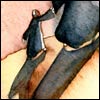Many pieces of fine art involve an interplay of light and shadow key elements in the composition of almost every artistic work. At first glance, a shadow appears to be something that conceals light. However, according to the teachings of Torah, everything G‑d created was for His glory. This must apply to the shadow equally as to the light.
Indeed, properly executed and skillfully placed, a shadow can also provide an important effect. Though the shadow’s “illumination” is of a different nature than the revelation and effect of the light, its appropriate application can actually enhance and highlight the effects of the light.
From this, we can derive an important lesson whenever we encounter dark times and in our times when spirituality is less visible, these dark times may seem more numerous than the good. We should use the negative in a positive way, so that every spiritual “shadow” should come to be recognized as a “setting” that highlights the glory of the Creator.
When this goal is achieved, not only will our appreciation of the light be enhanced by contrast with the darkness, but in many situations where a person is confronted with “dark” matters, he will realize his ability to transform the darkness itself into light, “the sorrow into happiness.”
Letter of the Rebbe, 25 Sivan, 5737,
printed in Likkutei Sichos, Vol. 23, p. 341ff.








Join the Discussion